Akira Toriyama’s Lost Interview in Germany
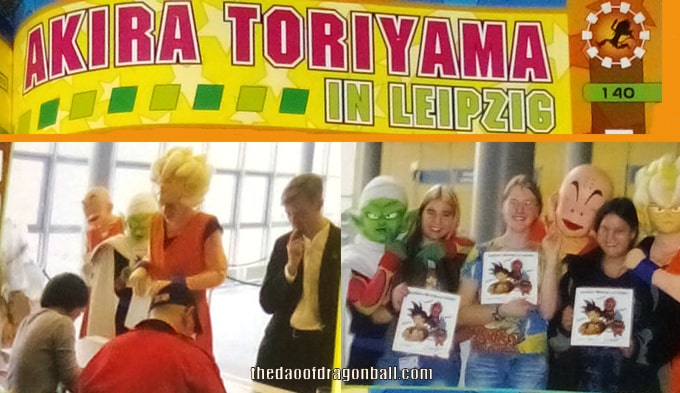
Akira Toriyama’s long-lost interview in Germany has been recovered! It took 15 years, but I’ve translated it for the first time!
This rare event is finally available to the world.
History of Toriyama’s Trip to Germany
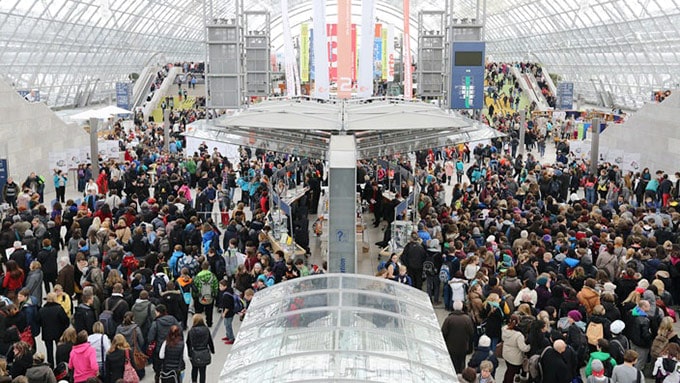
I first wrote about Akira Toriyama’s 2004 trip to Germany on July 26, 2014.
In this article I told the story of how Toriyama attended the 2004 Leipzig Book Fair in Leipzig, Germany.
The short version is that Toriyama was invited by Carlsen Comics, the German licensor and publisher of Toriyama’s Dragon Ball.
Toriyama’s arrival was big news. There was a huge demand to see him by those attending the fair.
But because Toriyama is shy and doesn’t like crowds, only a select audience of 200 attendees were chosen by raffle.

After a long wait, Toriyama walked on stage to a loud applause.
He then answered questions and delivered a drawing lesson to the audience.
Given Toriyama’s concern over being photographed, pictures were forbidden. To quote a 2004 article on the German website mdr.de, “If, however, someone pulls out a camera, the action is cancelled immediately.”
Despite this rule and the strict consequences, while Toriyama was drawing a picture of Son Goku on stage, someone took a picture of Toriyama without his knowledge.

This is the last known image taken of Toriyama at a staged event. And as you can see, he is wearing a red tracksuit, similar to the one that Goku wears in Dragon Ball Z: Battle of Gods, the one Gohan wears in Dragon Ball Z: Resurrection ‘F’, and the one Android 18 wears in Dragon Ball Super.
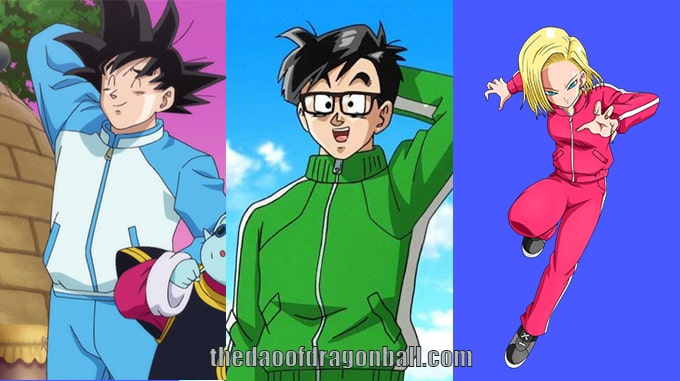
After failing to find Toriyama’s interview and drawing lesson online, I accepted that they had been lost to time.
However, after I published this article, I heard from German readers that both the interview and lesson were published in BANZAI! magazine, Issue #6, 2004.
BANZAI! was the German equivalent of the Japanese Weekly Shōnen Jump, and it featured many Japanese manga popular among children, such as Dragon Ball.
I searched online for a copy of this magazine and was able to find one on the German eBay, but I could not afford the $50 price. Alas, the life of a struggling Dragon Ball Scholar!
So for years my goal of acquiring and translating the interview sat in my ‘someday folder,’ once I made it big—which I’m still waiting for.
Then how did I get the interview?
Thankfully, last week I was contacted by a German reader who came across my original article. He saw where I wrote, “Does anyone out there have a copy of the magazine? If so, please send me a picture of the interview!” And that’s exactly what he did.
The reader who sent me the interview requested his name be withheld, so you can thank ‘German DBZ Fan’ in the comments.
Once I had the images, I transcribed the text by hand, translated it from German to English, and cleaned it up to match Toriyama’s personality in other interviews.
I also added explanatory footnotes to Toriyama’s comments, which you can read after the interview.
This is the only interview Akira Toriyama has ever conducted in German. This is noteworthy because there is no public record of his original Japanese words. We only have the German translation as published in BANZAI![i]
So now it’s finally here. It required 5 years of patience for a German reader to come across my article and have the interview in hand, and 15 years in total for Toriyama’s words to be made available to the world.
Thus, without further ado, here is…
Akira Toriyama’s lost interview in Germany!
Akira Toriyama in Leipzig

Introduction: On Saturday, it was finally time! For many, the absolute highlight of the fair: The Master, Akira Toriyama, answered your questions live on stage! Of course, BANZAI! presents the whole interview again for all of you who could not be in Leipzig. Besides that, we also have a few additional questions to present, which you sent in advance by e-mail.
BANZAI!: Toriyama-sensei, you are now well-known all over the world. What does that feel like, and how do you personally handle having so much excitement over you as a person?
Akira Toriyama: I am happy that my work is famous, but personally I am very shy and would prefer to not be famous. That’s why I don’t publish any photos of myself, so that nobody will recognize me and I’ll live a quiet, normal life.
BANZAI!: At what age did you start drawing manga?
Akira Toriyama: Ah, I started when I was 21. That was when I actually wanted to become a mangaka.
BANZAI!: What was your career aspiration as a child?
Akira Toriyama: As a kid I wanted to be an artist.[ii]
BANZAI!: What was the feeling like when you held your first published work?
Akira Toriyama: Of course I was very happy. But I was used to holding things in print because I had previously worked in advertising. After all, my parents used to often say, “Do something decent! And don’t always draw manga!” Having that [job] made it easier for me to keep drawing.

crowd for Toriyama; signed artwork for attendees; drawing of Son Goku, addressed to Carlsen Comics
BANZAI!: Which manga did you read before then, and which mangaka influenced your art?
Akira Toriyama: To be honest, I haven’t read many works by other mangaka, except in my childhood I read Astro Boy by Osamu Tezuka. But recently, my wife and children have been wild about 20th Century Boys by Naoki Urasawa.[iii] It reached the point where I didn’t understand what they were talking about, so I decided to read the manga. I liked it better than most movies. If I read more manga, I could probably name other mangaka that are just as great.
BANZAI!: How do you come up with your ideas? Do you have a special trick?
Akira Toriyama: Getting ideas is difficult. You have to open your sketchbook and go through different concepts. Since I’m not an ordinary guy, I try to avoid simple stories.[iv] The right combination of firmly planned ideas and spontaneous ideas that come to mind is very important.
BANZAI!: How does the collaboration between you, the publisher, and the editor work?
Akira Toriyama: Normally, the relationship between an author and their editorial staff should work so that if something is not quite right, the editor will discover that mistake and then steer the work in the right direction. My editor, Torishima-san, had many good ideas, which I often implemented. However, there were some that I did not like. I’d say, “That’s a good idea,” to make him happy, but then I’d kill the idea behind his back. I have picked up on his most brilliant ideas, and gradually added them to my work. I think he didn’t make it easy for me because I didn’t always listen to him.[v]
Interview with Akira Toriyama – Page 2
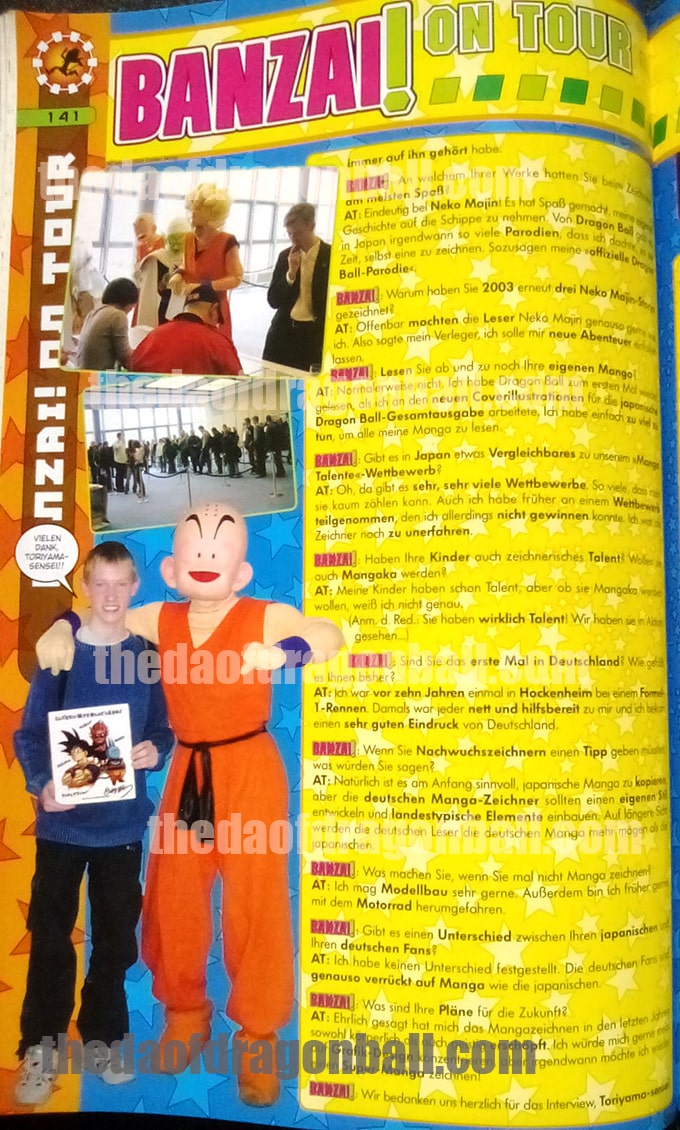
BANZAI!: Which of your works did you have the most fun drawing?
Akira Toriyama: Definitely Neko Majin![vi] It’s a fun look at my most famous story. With Dragon Ball, in Japan, there are so many parodies that I thought ‘it’s time to draw one myself.’ My “official Dragon Ball parody,” so to speak.
BANZAI!: Why did you draw three Neko Majin stories again in 2003?
Akira Toriyama: Apparently readers liked Neko Majin, in a nutshell. So my publisher said I could create new adventures.
BANZAI!: Do you occasionally read your own manga?
Akira Toriyama: Not usually. I read Dragon Ball for the first time while working on the new cover artwork for the Japanese Dragon Ball Kanzenban Edition.[vii] I just have too much to do to read all my manga.
BANZAI!: Is there anything comparable in Japan to our “Manga Talents” competition?[viii]
Akira Toriyama: Oh, there are many competitions. So many that you can hardly enter them all. I, too, took part in a competition earlier but could not win. I was still too inexperienced.[ix]
BANZAI!: Do your children also have drawing talent? Do you want them to be mangaka too?
Akira Toriyama: My children do already have talent, but I don’t know if they want to become mangaka.
(Editor’s Note: You really have talent! We’ve seen you in action…)
BANZAI!: Is this your first time in Germany? How do you like it so far?
Akira Toriyama: Twenty years ago, I was in Hockenheim for a Formula 1 race. At that time everyone was nice and helpful to me and I got a very good impression of Germany.[x]
BANZAI!: If you had to give a tip to junior illustrators, what would you say?
Akira Toriyama: Of course it makes sense in the beginning to copy Japanese manga, but the German manga artists should develop their own style and incorporate country-specific elements. As time goes on, the German readers will prefer the German manga over the Japanese.
BANZAI!: What do you do when you’re not drawing manga?
Akira Toriyama: I really like model making.[xi] Besides that, I used to ride around on my motorcycle.[xii]
BANZAI!: Is there a difference between your Japanese fans and German fans?
Akira Toriyama: I didn’t notice any difference. The German fans are just as crazy about manga as the Japanese.
BANZAI!: What are your plans for the future?
Akira Toriyama: Honestly, manga drawing has exhausted me both physically and mentally over the past year. I’ve been more focused on graphic design lately, but eventually I want to draw a Super-manga![xiii]
BANZAI!: We thank you for the interview, Toriyama-sensei.
History in the Making
There you have it! This interview was 15 years in the making, and now it’s available to the rest of the world!
Before you get to the explanatory notes on Toriyama’s comments below, I want to mention a couple of key points in more detail.
The first is about the illustrations that these fans are holding.
Toriyama’s Rare Illustration Collectible
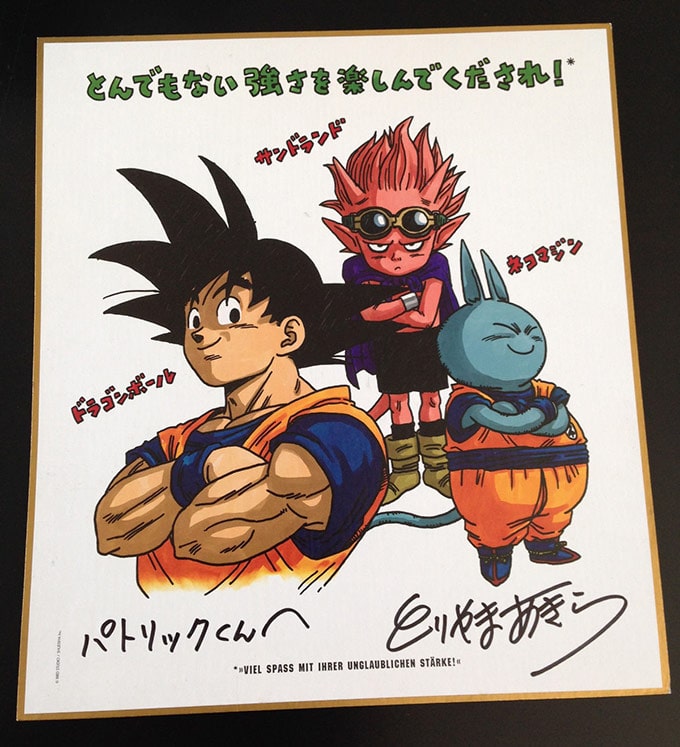
15,000€ (~ $16,900).
That’s what one of these 200 collectibles signed to the attendees sold for on the German eBay on July 23, 2015.
Each of the 200 who waited in line received such a drawing made by Toriyama just for this event.
In Japanese this image is called a shikishi (色紙, “drawing paper”).
A shikishi is a fine handmade paper that is laminated to a hard board tacking. The edge is decorated with a strip of gold paper. They are often used for illustrations, paintings, or calligraphy, and shikishi from Japanese mangaka are a collectible item.
Toriyama’s shikishi consists of three characters from Toriyama’s manga, with the name of each manga written next to it. On the left is Son Goku, from Dragon Ball. On the right is Neko Majin from Neko Majin. In the rear is Beelzebub, from Sand Land.
At the top, the message reads Tondemonai tsuyosa o tanoshinde kudasare (とんでもない強さを楽しんでくだされ, “Enjoy their incredible strength!”). It says the same thing in German at the bottom, as “Viel Spass Mit Ihrer Unglaublichen Starke!”
Each image was custom signed to the person, in the bottom left. As you can see in this picture, each attendee waited in line and walked up to Toriyama at his table.
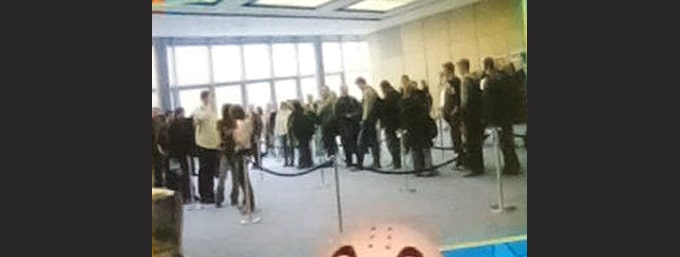
Then, based on the fact each illustration has a unique name written on them, it can be surmised that the attendee told their name to the translator sitting to Toriyama’s left, and then Toriyama would write the equivalent of their name in Japanese.

In this case, Patrick, written as Patorikku-kun (パトリックくん, “Patrick-kun”).
Toriyama’s name is signed on the bottom right.
These shikishi from Toriyama are extremely valuable!
How much would you pay for one of Toriyama’s shikishi?
Toriyama’s Formula 1 Trip
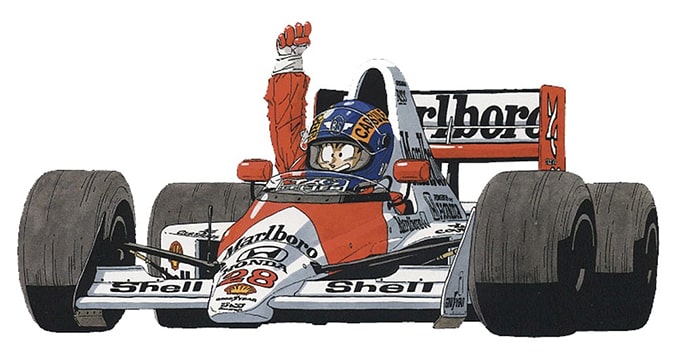
The other point to highlight is when Toriyama says, “Twenty years ago, I was in Hockenheim for a Formula 1 race.” This is new information!
This Leipzig interview was conducted in 2004, which means Toriyama visited Germany in 1984.
We can then infer he means the 1984 German Grand Prix, held at Hockenheim on August 5, 1984.
This race was won by French driver Alain Prost, driving a McClaren-TAG. Unfortunately, Toriyama’s favorite driver, the Brazilian star Ayrton Senna, crashed out.
What we already knew before this interview, is that Toriyama later visited Germany in 1990 to attend another Formula 1 race. It was here where he met Ayrton Senna in person and shook his hand.
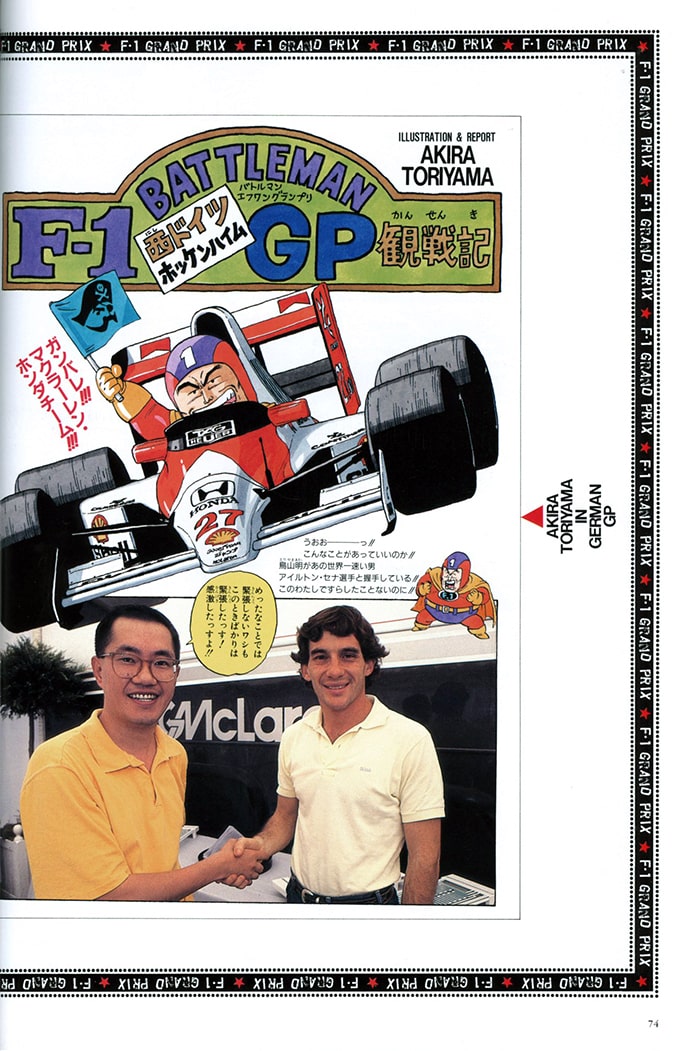
Toriyama then drew Goku driving Ayrton Senna’s car, the 1990 McClaren MP4/5.
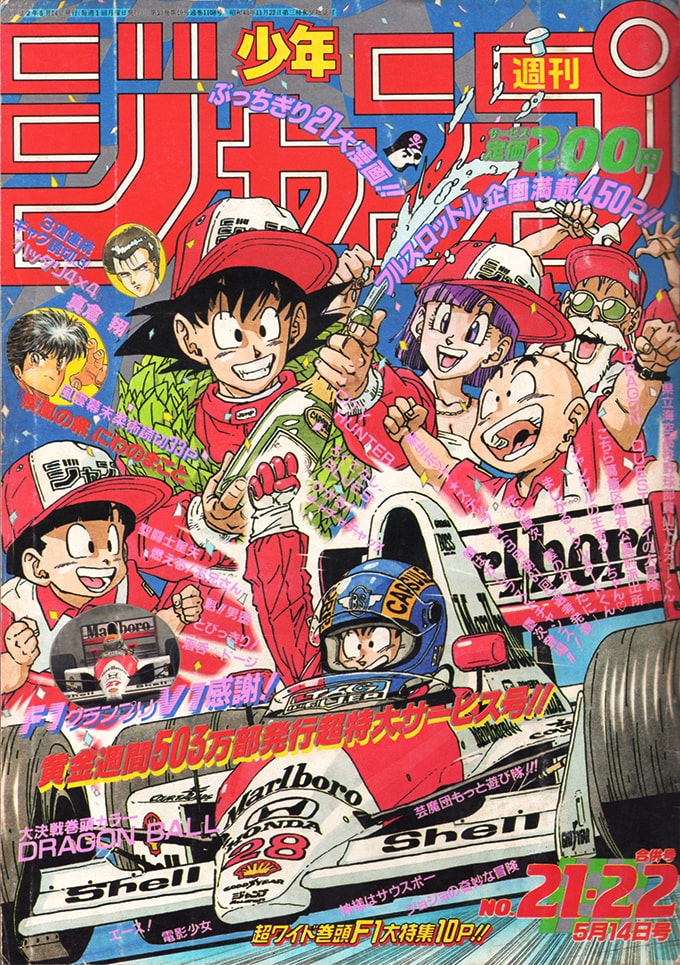
This is the cover of Weekly Shōnen Jump #21-22, for the week of May 14, 1990. You can see Goku raising his fist in triumph as he wins the race, while his pit crew of Bulma, Krillin, Roshi, and Gohan celebrate.
At one point, Shonen Jump even sponsored Ayrton Senna’s car and placed their branding on the nose. It says JANPU (ジャンプ, “JUMP”), from the full name of Shōnen Jump (少年ジャンプ). It’s also located on the hats of Goku’s crew on the cover art.

image by start.uol.com.br
Ayrton would go on to win the F1 championship from 1988 to 1991.
There are more details to this moment in history and its relationship to Toriyama and Dragon Ball that I will reveal in a future article.
What I want to highlight here is that Toriyama says he visited Germany for the Formula 1 race prior to the earliest known date of 1990. Turns out he also visited in 1984.
For people who love Toriyama trivia, that’s a nice bit of new info.
Conclusion
That concludes the long-lost interview with Toriyama in Leipzig, Germany!
Did you learn anything new? Find anything funny?
Come back this Wednesday for the second part of Toriyama’s trip to Germany, where he teaches the lucky audience how to draw an entire page of manga!
Explanatory Notes
[i] For reference purposes, Toriyama’s interview is published in pages 140 to 141 of BANZAI! #6, 2004. His manga lesson is on pages 142 to 143.
[ii] I translated the German word maler as ‘artist,’ even though it is more often translated as ‘painter.’ This is because in previous interviews Toriyama has expressed his interest as a child of wanting to be an artist via his love of illustration and cartooning, rather than painting. If he really did mean ‘painter,’ then this would be new information.
[iii] 20th Century Boys (20世紀少年, Nijūseiki Shōnen) is a hit Japanese manga series written and illustrated by Naoki Urasawa. It was originally serialized in Big Comic Spirits from 1999 to 2006. Toriyama mentions it in 2004, which implies that he was reading the series while it was still being serialized. This is rare for Toriyama to do.
[iv] Another way to translate the German word of einfach (“simple”) is “straightforward,” “uncomplicated,” or “elementary.” So Toriyama is saying that because his personality is abnormal, he prefers to avoid making stories that are too simple and straightforward. He has made similar comments in previous interviews, where he states that he tries to disappoint his fans on purpose because he is “perverse.”
[v] Toriyama’s complaints about his editor, Kazuhiko Torishima, are common in his interviews. This is especially true during Toriyama’s rise to stardom in the early 1980s, with work on his famous Dr. Slump. At this time, Toriyama said Torishima-san’s most common phrase in regard to his ideas was, “REJECTED!” Toriyama disliked his editor so much that he used his likeness and name for a character in Dr. Slump: the evil scientist, Dr. Mashirito.
[vi] Neko Majin (ネコマジン, loosely ‘Magic Cat Neko’) is a parody manga by Akira Toriyama about a magic cat with supernormal powers. The main character wears the same dōgi (“martial arts uniform”) as Goku in Dragon Ball.
[vii] Dragon Ball Kanzenban (“Perfect”) Edition is a re-release of the series that began to be published in Japan on December 4, 2002. It was released in 34 volumes, rather than 42. Toriyama drew new cover art for all 34 volumes. As he says in this interview, he read Dragon Ball for the first time in order to become familiar with it again so that he could draw the art.
[viii] The “Manga Talents” competition refers to the Rising Stars of Manga talent competition. It was sponsored by TokyoPop, a global publisher of manga based in America. They had a German office in Hamburg, and the talent search for aspiring mangaka extended to German citizens. The contest began in 2002 and ended in 2008, with winners receiving publishing deals.
[ix] Toriyama took part in a Shōnen Jump manga competition in 1977. He did so in order to win a cash prize of 100,000 yen (~$1,000 USD) and publication in the manga. With no thoughts of become a professional mangaka. Toriyama did not win the competition, but his future editor, Kazuhiko Torishima, noticed Toriyama’s talent, called him, and inspired him to submit more work to him personally. After 500 failed attempts, he finally found success and got a submission published. This was the start of the now world famous Toriyama.
[x] Hockenheim is the location of the Formula 1 race in Germany. Toriyama attended the race “20 years ago,” which would make it the 1984 event. He attended again in 1990.
[xi] Toriyama is obsessed with making miniatures. His favorites are World War II replicas and dioramas, science-fiction meka, and real-life cars, motorcycles, and planes. During the creation of Dragon Ball, his home office was often filled with stacks of boxes from model kits.
[xii] Toriyama is a motorcycle aficionado. He grew up with a father who owned an auto mechanic shop, where the young Toriyama learned to appreciate bikes. While creating Dragon Ball, he would often ride his motorcycle around town in order to relax.
[xiii] Toriyama’s statement that he wants to one day draw a ‘Super-manga!’ may seem prophetic in light of the fact that Dragon Ball Super would one day premiere in 2015. The difference here is that Toriyama did not draw it. He instead wrote it, while his protégé, Toyotarō, illustrated it. But perhaps this statement suggests that Toriyama had the title of Dragon Ball Super in mind even back in 2004. Or maybe he simply meant ‘Super’ as a synonym for a ‘great’ and ‘grand’ manga to come.
Translations
Translations of this article have been made by fans across the world.
' . $comment->comment_content . '
'; } } else { echo 'No comments found.'; }